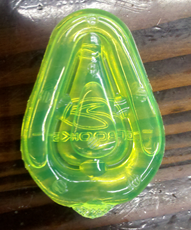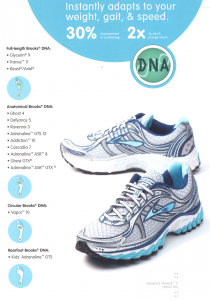Background
There is some interest in the differences between Brooks old technology, Hydroflow, and their new technology, DNA. Hydroflow has been in Brooks line for over 20 years and was a very successful cushioning supplement in their shoes. DNA is trickling down their shoe line one shoe at a time and about half of their shoes have the new cushioning supplement as of this posting.
Hydroflow
Hydroflow is a silicone fluid encased by a chambered plastic shell. The system works by allowing fluid to pass freely between an inner and outer chamber, as shown by the following diagram and real Hydroflow heel unit.


When pressure is applied to the center chamber (the center of the heel) the fluid flows from the inner chamber to the outer chamber forming a cup shape around the heel. Brooks was really ahead of their time when this debuted. Some of Brooks shoes also have a forefoot Hydroflow unit which functions in the same manner, although shaped differently.
DNA
Brooks newest technology is DNA, a non-Newtonian substance. Non-Newtonian substances react differently than typical substances in the way that they react to pressure. Here’s a little orientation to better explain the material.
http://www.youtube.com/watch?v=ThGqpFgThEM
To get a better idea of how this fits into the shoe, take a look at the following pictures. The first is a picture of full-length DNA in the Brooks Beast next to a heel unit, the second is a close-up of a single DNA heel unit.


Not all of the DNA shoes currently have the full-length DNA like the Beast. Some of the shoes such as the Adrenaline GTS 11 have separated heel and forefoot DNA.
Comparison
These two cushioning systems are both great, but from what we have seen from our customers the DNA is a big improvement. The Beast and the Ariel have both been performing very well due to the addition of full-length DNA. Although Hydroflow was a very good system, it was time for Brooks to take a step forward with their technology, and is one of the reasons that they have surpassed Asics in the running specialty market.
For a size comparison, check out the following picture.

There is not a lot of difference in the size of the two heel units, but where the most difference is shown is when the Hydroflow unit is placed atop the full-length DNA, as shown.

That’s a huge difference in under the foot protection. DNA is really a cool feature, especially in it’s full-length configuration. I can’t wait to see this in their other shoes!
An Aside
The cushioning materials discussed in this article are supplementary, the main cushioning material in nearly all running shoes is made of EVA or similar materials. EVA is the usually-white material that your feet ride on. These supplementary cushioning devices are embedded in the EVA to give it that little extra bit of bounce, but the bulk of your cushioning almost always comes from the “normal” midsole materials like EVA. Basically this means that you shouldn’t buy a shoe based on what the little pod is inside, buy the shoe because it fits and is the right shoe for your gait!
I hope this article helped you out with your questions related to Brooks’ new technologies, and thank you for reading. Let us know what you thought and please leave a comment!
Update
There is more information on which shoes have DNA, and in what configuration. See the following picture:

Full-length DNA (the best) is available in the Glycerin 9, Trance 11 and Beast/Ariel.
Anatomical DNA is available in the Ghost 4, Defyance 5, Ravenna 3, Adrenaline GTS 12, Addiction 10, Cascadia 7, Adrenaline ASR 8, Ghost GTX, and Adrenaline ASR GTX.
Circular DNA (which isn’t that interesting) is available in the Vapor 10.
Additionally, the kids Adrenaline has DNA in the heel only.
Presumably this will also carry forward on future models.

thanks for the insight and research …of Brooks shoes..